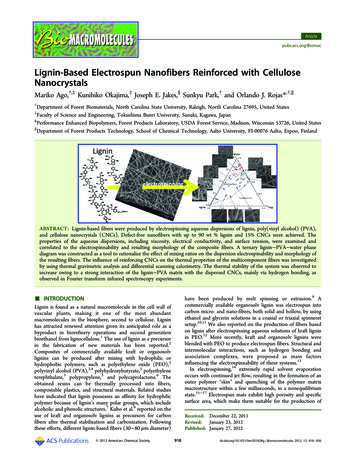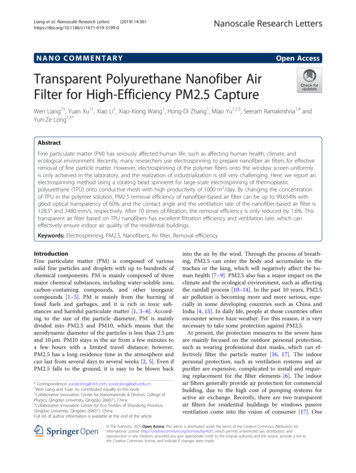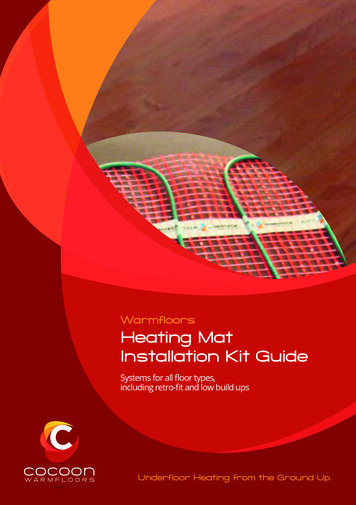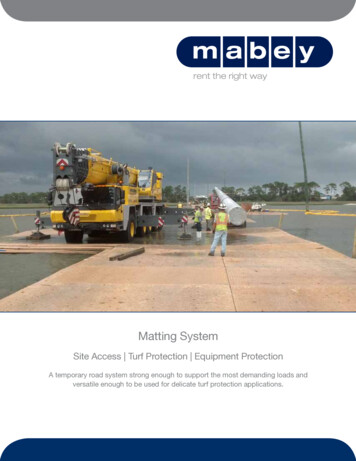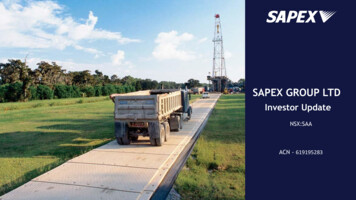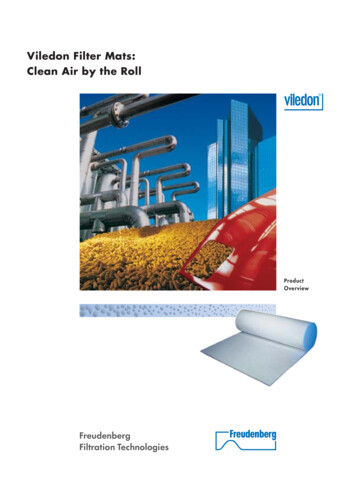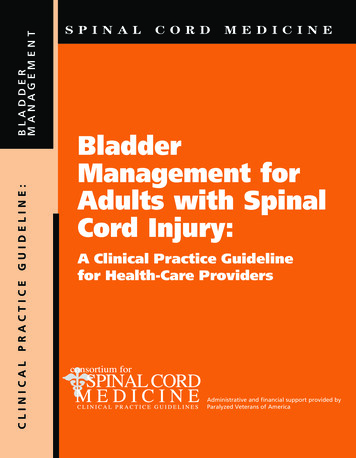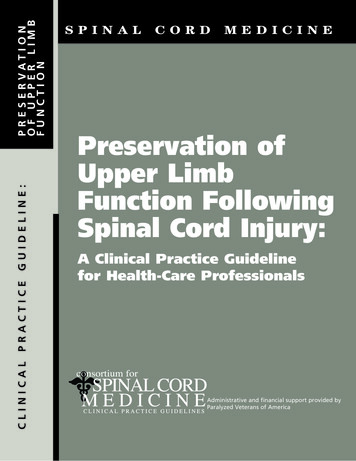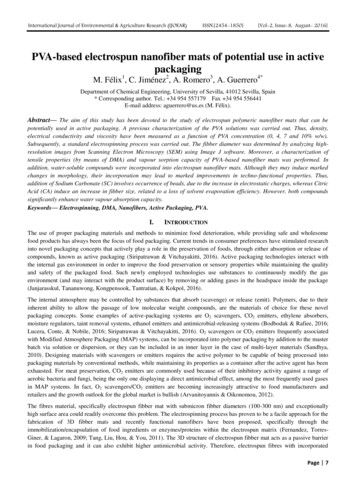
Transcription
International Journal of Environmental & Agriculture Research (IJOEAR)ISSN:[2454-1850][Vol-2, Issue-8, August- 2016]PVA-based electrospun nanofiber mats of potential use in activepackagingM. Félix1, C. Jiménez2, A. Romero3, A. Guerrero4*Department of Chemical Engineering, University of Sevilla, 41012 Sevilla, Spain* Corresponding author. Tel.: 34 954 557179 Fax 34 954 556441E-mail address: aguerrero@us.es (M. Félix).Abstract— The aim of this study has been devoted to the study of electrospun polymeric nanofiber mats that can bepotentially used in active packaging. A previous characterization of the PVA solutions was carried out. Thus, density,electrical conductivity and viscosity have been measured as a function of PVA concentration (0, 4, 7 and 10% w/w).Subsequently, a standard electrospinning process was carried out. The fibber diameter was determined by analyzing highresolution images from Scanning Electron Microscopy (SEM) using Image J software. Moreover, a characterization oftensile properties (by means of DMA) and vapour sorption capacity of PVA-based nanofiber mats was performed. Inaddition, water-soluble compounds were incorporated into electrospun nanofiber mats. Although they may induce markedchanges in morphology, their incorporation may lead to marked improvements in techno-functional properties. Thus,addition of Sodium Carbonate (SC) involves occurrence of beads, due to the increase in electrostatic charges, whereas CitricAcid (CA) induce an increase in fibber size, related to a loss of solvent evaporation efficiency. However, both compoundssignificantly enhance water vapour absorption capacity.Keywords— Electrospinning, DMA, Nanofibers, Active Packaging, PVA.I.INTRODUCTIONThe use of proper packaging materials and methods to minimize food deterioration, while providing safe and wholesomefood products has always been the focus of food packaging. Current trends in consumer preferences have stimulated researchinto novel packaging concepts that actively play a role in the preservation of foods, through either absorption or release ofcompounds, known as active packaging (Siripatrawan & Vitchayakitti, 2016). Active packaging technologies interact withthe internal gas environment in order to improve the food preservation or sensory properties while maintaining the qualityand safety of the packaged food. Such newly employed technologies use substances to continuously modify the gasenvironment (and may interact with the product surface) by removing or adding gases in the headspace inside the package(Janjarasskul, Tananuwong, Kongpensook, Tantratian, & Kokpol, 2016).The internal atmosphere may be controlled by substances that absorb (scavenge) or release (emit). Polymers, due to theirinherent ability to allow the passage of low molecular weight compounds, are the materials of choice for these novelpackaging concepts. Some examples of active-packaging systems are O2 scavengers, CO2 emitters, ethylene absorbers,moisture regulators, taint removal systems, ethanol emitters and antimicrobial-releasing systems (Bodbodak & Rafiee, 2016;Lucera, Conte, & Nobile, 2016; Siripatrawan & Vitchayakitti, 2016). O2 scavengers or CO2 emitters frequently associatedwith Modified Atmosphere Packaging (MAP) systems, can be incorporated into polymer packaging by addition to the masterbatch via solution or dispersion, or they can be included in an inner layer in the case of multi-layer materials (Sandhya,2010). Designing materials with scavengers or emitters requires the active polymer to be capable of being processed intopackaging materials by conventional methods, while maintaining its properties as a container after the active agent has beenexhausted. For meat preservation, CO2 emitters are commonly used because of their inhibitory activity against a range ofaerobic bacteria and fungi, being the only one displaying a direct antimicrobial effect, among the most frequently used gasesin MAP systems. In fact, O2 scavengers/CO2 emitters are becoming increasingly attractive to food manufacturers andretailers and the growth outlook for the global market is bullish (Arvanitoyannis & Oikonomou, 2012).The fibres material, specifically electrospun fibber mat with submicron fibber diameters (100-300 nm) and exceptionallyhigh surface area could readily overcome this problem. The electrospinning process has proven to be a facile approach for thefabrication of 3D fibber mats and recently functional nanofibers have been proposed, specifically through theimmobilization/encapsulation of food ingredients or enzymes/proteins within the electrospun matrix (Fernandez, TorresGiner, & Lagaron, 2009; Tang, Liu, Hou, & You, 2011). The 3D structure of electrospun fibber mat acts as a passive barrierin food packaging and it can also exhibit higher antimicrobial activity. Therefore, electrospun fibres with incorporatedPage 7
International Journal of Environmental & Agriculture Research (IJOEAR)ISSN:[2454-1850][Vol-2, Issue-8, August- 2016]enzymes (as antimicrobial agent) could be ideal as food packaging materials where they can act as killing agent and/or inhibitbacteria growth on surface of foods and allow or facilitate the development of new and healthier food products.Additionally, fibber diameter and fibber mat architectures are tuneable by simply varying process and material parameterssuch as cospinning polymer, solution viscosity and conductivity, voltage, flow rate, nozzle-collector distance, and collectionmethod (Bhardwaj & Kundu, 2010). Electrospun nanofibers offer many advantages over traditional fibres including highsurface area to volume ratio, tuneable porosity, and ease of manipulating fibber chemical compositions and structures fordesired properties and functionalities. While electrospinning serves as a technique with great potential for the delivery ofingredients for functional food products and active packaging, several challenges remain unresolved (Bhushani &Anandharamakrishnan, 2014).The aim of this work has been to study new materials of potential use in active packaging. To achieve this objective, newelectrospun mats, which exhibit novel properties related to food preservation such as CO 2 release, have been evaluated.Polyvinyl alcohol (PVA) aqueous solutions have been processed through electrospinning at different PVA concentrations.Electrospun PVA nanofiber mats have been characterized by means of Dynamic Mechanical Analysis (DMA), using bothoscillatory dynamic and uniaxial tensile tests, and Scanning Electron microscopy (SEM). In addition, water vapourabsorption capacity was determined. To improve this ability, the effect of addition of two different compounds was alsoevaluated: Sodium Carbonate (SC) and/or Citric Acid (CA).II.2.1MATERIALS AND METHODSMaterialsPolyvinyl alcohol (PVA), Sodium Carbonate (SC) and Citric Acid (CA) were purchased from Sigma & Aldrich(Zwijndrecht, The Netherlands).2.2Methods2.2.1Electrospinning conditionsThe electrospun nanofiber mat selected as the reference system was processed using a 7% PVA aqueous solution atthe following conditions: 12 kV as the voltage applied; 0.4 mL/h as the flow rate; 10 cm as the distance between the tip of theneedle and the collector. In addition, Sodium Carbonate (SC) or Citric Acid (CA) was added to the raw PVA solution usedfor the electrospinning process at concentrations of 2 and 3 wt.%, respectively, in order to obtain SC or CA loaded mats. Acombined mat formed from two independent syringes by alternative SC-loaded and CA-loaded layers was also evaluated.The effect of the presence of the compounds was analysed by determining the modifications produced on the water vapourabsorption capacity.2.2.2Physicochemical characterization of PVA solutionsThe pH of the aqueous PVA solutions was determined by using a CyberScan pH 1500 (Eutech Instruments), whereas theelectrical conductivity was measured with a EC-Meter Basic 30 (Crison instruments) equipment. The density was obtainedby means of a Densito 30PX Portable Density Meter (Mettler Toledo). All the measurements were determined at 25ºC.Viscosity measurements of PVA solution were carried out by means of an AR2000 (TA Instruments, New Castle, DE, USA)rheometer. All the rheological measurements were carried out at 25ºC using 60 mm diameter aluminium serrated plates.Flow curves from 0.1 to 10 Pa were carried out in order to obtain the shear viscosity.2.2.3Mechanical characterization of matsOscillatory dynamic tensile tests were carried out with a RSA3 (TA Instruments, New Castle, DE, USA), using rectangularspecimens. Firstly, strain sweep tests were performed to define the linear viscoelastic region. Subsequently, frequency sweeptests were carried out from 0.01 to 20 Hz, at constant strain amplitude (between 0.01 and 0.30%, within the linearviscoelastic region).Uniaxial tensile tests were performed at constant extensional rate of 1 mm/min up to breakup by using the RSA3 equipment.Tensile strength parameters were evaluated from at least three duplicates for each product obtained at 25ºC.Page 8
International Journal of Environmental & Agriculture Research (IJOEAR)2.2.4ISSN:[2454-1850][Vol-2, Issue-8, August- 2016]Scanning Electron Microscopy (SEM)Images of the fibres were obtained using a JEOL 6460LV (Tokyo, Japan) at an acceleration voltage of 10 kV, where thedistance between the sample and the detector was between 2 and 5 mm. The specimens were previously coated with a goldfilm. Image analysis, using ImageJ software, was used to obtain the diameter of the fibres from each SEM image.2.2.5Water vapour absorptionThe vapour absorption of electrospun mats was measured in controlled atmospheres. Thus, samples were previously dried inan oven at 50ºC for 24h and then left until equilibrium at four different relative humidity: 32.8, 52.9, 75.3 and 100% HR.Samples were weighted before and after being kept into the controlled atmospheres, the water uptake was calculated asfollows:Where Wf is the weight of the sample after reaching the equilibrium into the controlled atmosphere and Wd is the weight ofthe dried sample.III.3.1RESULTS AND DISCUSSIONPVA aqueous solutionsFigure 1 shows values of conductivity, density and dynamic viscosity for the PVA aqueous solution studied. The pH valuefound for the PVA aqueous solutions is slightly acid (5.3 0.1), being similar to that one found for distilled water, which hasbeen associated to presence of solved CO2 (Company & Kemmer, 1979). As may be observed, the presence of PVA increasesthe conductivity of water. However, this increase, which fits to a second degree polynomial equation, is not as high as theone found for inorganic salts, which typically fits to an exponential equation.FIGURE 1. ELECTRICAL CONDUCTIVITY, DENSITY AND DYNAMIC VISCOSITY FOR PVA DISSOLVED IN WATERAT FOUR DIFFERENT CONCENTRATIONS (0, 4, 7 AND 10 WT.%) AT 25ºCThe increase in PVA concentration also involves an increase in density, fitting a slow increasing second degree polynomialequation. As for the viscosity, PVA aqueous solutions show a Newtonian behaviour within the concentration range studied(from 0 to 10 wt.% PVA). Zadeh et al.(2014) found similar results but they obtained small deviations for PVA concentrationsabove 7 wt.%. As may be observed in Figure 1, the change in PVA concentration has a marked influence on the apparentviscosity, which fits to an exponential equation. In view of these results it is expected that the electrospinning process willshow a strong dependence on the concentration of the PVA aqueous solutions.3.2PVA-based elctrospun nanofiber mats3.2.1Scanning Electron MicroscopyFigure 2 shows the SEM images of electrospinning mats obtained at the selected conditions (12kV, 0.4 mL/min and 10 cmdistance) as a function of PVA content. As may be observed in this figure, the fibres obtained from each solution arerandomly distributed on the collected final mat, forming a non-woven network. The fibres obtained show diametersPage 9
International Journal of Environmental & Agriculture Research (IJOEAR)ISSN:[2454-1850][Vol-2, Issue-8, August- 2016]corresponding to the nanoscale, whose thickness depends on the processing time. The fibres obtained from the 7 wt.% PVAsolution show a mean diameter of 172 6 nm, which corresponds to a specific surface in the order of 10 7 m-1. This meansthat an electrospun nanofiber mat having a volume of 1 cm3, would possess an exposed surface of ca. 17 m2.FIGURE 2. SEM MICROSCOPY IMAGES OF A MAT MADE FROM 4 (A), 7 (B) AND 10 (C) WT. % PVASOLUTIONS, 12 kV AND 0.4 mL/h, AS WELL AS BAR GRAPH SUMMARIZING THE MEAN NANOFIBER DIAMETER.As may be seen in this figure, more specifically in Fig. 2D, an increase in PVA content from 4 to 7 wt.% leads to an apparentreduction in the average diameter. A further increase also tends to produce thinner fibres but in this case they are combinedwith higher sizes, such that a much wider distribution may be clearly observed. Therefore, an intermediate value (i.e. 7 wt.%PVA) seems to be the most convenient concentration to obtain small and fairly uniform nanofiber diameters.Figure 3 shows SEM images of electrospun nanofiber mats obtained from a 7 wt.% PVA solution at 0,4 mL/h flow rate, 10cm distance and different voltage values. An increase in electric potential difference from 9 to 12 kV leads to a networkenhancement in the nanofiber mat obtained since a clear reduction in average diameter takes place. A further reduction canbe obtained by increasing the voltage up to 15 kV, however only a 20% reduction in diameter is involved in this laterenhancement. It is also apparent that the lowest voltage value also gives rise to a wide distribution of sizes.FIGURE 3. SEM MICROSCOPY IMAGES OF A MAT MADE FROM 9 (A), 12 (B) AND 15 (C) kV, 7 wt.% PVA and0.4 mL/h, AS WELL AS BAR GRAPH SUMMARIZING THE MEAN NANOFIBER DIAMETER.Page 10
International Journal of Environmental & Agriculture Research (IJOEAR)3.2.2ISSN:[2454-1850][Vol-2, Issue-8, August- 2016]Rheological characterizationDynamic frequency sweep tests were carried out in tension mode to obtain the mechanical spectrum of the nano fiber matprepared at the reference conditions (7 wt.% PVA, 12kV, 0.4 mL/min and 10 cm). This measurement involves theapplication of constant uniaxial stress amplitude (within the linear viscoelastic range) at frequencies ranging from 0.01 to 20Hz. The mechanical spectrum obtained, which is plotted in Fig. 4, reflects a typical behaviour of a solid viscoelastic film,where the elastic response (E’) is much higher than the viscous response (E’’). Moreover, both moduli (particularly E’) showa fairly small dependence on frequency. The value of E’ (in the order of 108Pa) also reflects the suitable mechanicalproperties of the mat. In addition, the loss tangent (ranging from 0.2 to 0.06) indicates the clear predominance of the elasticcomponent of the viscoelastic response.FIGURE 4. LINEAR VISCOELASTIC PROPERTIES AS A FUNCTION OF THE FREQUENCY OF MAT MADE FROM 7wt. % PVA AQUEOUS SOLUTION, 12 kV and 0.4 mL/h3.2.3Tensile testsThe second test carried out in order to accomplish the mechanical characterization of the nanofiber mat was a uniaxial tensiletest up to breakup, which gives rise to the stress-strain curve. This test consists in the application of an elongational uniaxialstress, which is monitored at constant rate over time. Figure 5 shows the stress-strain curve for the reference PVA mat.FIGURE 5. STRESS-STRAIN CURVE FOR MATS AT 7 wt.% AQUEOUS SOLUTION PVA, 12 kV and 0.4 mL/h.A linear region of large slope, which is related to a good resistance against small strains and defines the Young’s modulus(E), characterizes the beginning of the stress-strain curve. This region is followed by a continuous increase in stress, takingplace with progressively lower slope, up to a maximum value reached at the plastic deformation region. After this maximumvalue, the stress goes down as a consequence of the reduction of the area of the probe. Finally, the fracture of the specimentakes place. As may be observed, the strain at break is lower than 10%. The E obtained for the mat of nanofibers is around8.0·107 Pa. This result is slightly higher than those obtained by other authors using different electrospinning techniques:4.13·107 Pa (Chen et al., 2011); 4.95·107 Pa (Li, Suo, & Deng, 2010) and 6.85·107 Pa (Strawhecker & Manias, 2000).Page 11
International Journal of Environmental & Agriculture Research (IJOEAR)ISSN:[2454-1850][Vol-2, Issue-8, August- 2016]Finally, the value of the maximum stress found is around 2.4 ·10 6 Pa. In any case, these results are in the order of magnitudeof the typical values obtained for commercial polymer materials such as those reported by Greesh & Luyt (2015) forPolystyrene-based materials.3.2.4Electrospun nanofiber mats loaded with inorganic compoundsOne of the advantages of using this kind of materials is their ability to incorporate a wide variety of soluble compounds,which may confer interesting properties in some relevant applications such as in active packaging. One of these properties isthe ability to absorb water from the environment. Thus, the effect of adding asoluble compound to 7 wt.% PVA aqueoussolution on the electrospun mat was evaluated. This compound was either Sodium Carbonate (SC) or Citric Acid (CA). Itshould be noticed that both compounds cannot be simultaneously added since they spontaneously react to produce thefollowing reaction that requires the presence of water to be initiated:(1)Therefore it is worth mentioning that SC and CA may coexist in solid state without reacting provided that the moisturecontent is low enough. As a consequence of this, a combined PVA-based elctrospun nanofiber mat formed by alternative SCloaded and CA-loaded layers may be also obtained. The effect of the presence of these compounds (SC and/or SC) wasanalysed by determining the modifications produced on the water vapour absorption capacity.3.2.5Moisture absorptionFigure 6 shows results obtained from moisture absorption by using Eq. (1) after keeping samples over 15 days in a controlledatmosphere at 32.8%, 52.9%, 75.3% and 100% RH. As may be observed, all mats exhibit a high water absorption capacity,which increases according to the RH.FIGURE 6. PERCENTAGE OF WATER ABSORPTION OF MATS AS A FUNCTION OF RH (%)This figure shows that all the mats have almost the same water absorption capacity up to a certain value of RH. Howeverafter this value (c.a. 75% RH) PVA mats loaded only with SC or CA show higher water absorption ability than the others.These results reflect the higher hydrophilic character of both compounds. However, a striking result seems to be obtained forthe moisture absorption of mixed SC CA mat, since it turns to be much lower than the values obtained for single loaded SCor CA mats, showing similar value to that of the unloaded PVA mat. This behaviour can be related to the occurrence of theabove-mentioned chemical reaction, taking place between the SC and the CA when critical moisture content is exceeded. Infact, the expected increase in weight due to moisture absorption associated to the hydrophilic character of SC and CA seemsto be counterbalance by some weight loss (e.g. due to CO2 release).3.2.6Scanning Electron Microscopy (SEM)Figure 7 shows SEM images of mats containing SC and CA where formation of nanofibers can be observed. The PVAconcentration was 7 wt.%, while the SC/PVA and CA/PVA was 20/80 and 30/70, respectively. Note that these proportionsare in accordance with the stoichiometry between the SC and the CA of the above-described chemical equation.Page 12
International Journal of Environmental & Agriculture Research (IJOEAR)ISSN:[2454-1850][Vol-2, Issue-8, August- 2016]Initially, the ratio SC/PVA 30/70 was also studied, however mats changed from 2D to 3D structure (cotton-like structure),which showed a fairly poor uniformity, as a consequence of the electrostatic repulsions. According to Bhardwaj y Kundu(2010) solutions which contains a high concentration of charges are extremely unstable when an electrostatic field is applied.This effect is related to fast and random movements of the strand, which induces the 3D structure, as well as a decrease infibres uniformity.FIGURE 7. SEM IMAGES OF NANOFIBERS OBTAINED AFTER ADDING EITHER SC (A) OR CA (B) TO AQUEOUSSOLUTIONS OF 7 wt.% PVA.As may be deduced from SEM images both mats show a very different morphology with regard to the reference system andto each other. Thus, the mat containing SC is characterized by an alternation of fibres with a reduced diameter ( 150 nm) andfibres with beads that cannot observe that in the reference system. This effect is related with the strong presence of charges inthe solution.On the other hand, the presence of CA induces formation of fairly planar fibres with thicker diameter values ( 350 nm). Thefibres also seem to have a higher number of “melted” points, suggesting a poorer efficiency of solvent elimination. Zhang etal. (2005) also found this effect in PVA solutions with a low degree of hydrolysis. They related this morphology to matswhich retain solvent when the fibber is placed on the collector.IV.CONCLUSIONElectrospinning of PVA solutions at moderate concentrations leads to mats that consist of a network of randomly distributednon-woven fibres showing uniform sizes, in the order of 200 nm. Viscoelastic characterization from rheologicalmeasurements shows the typical response for a solid viscoelastic film. Moreover, parameters from stress-strain curvesindicate that the mats obtained from the electrospun process are suitable for a commercial use.In addition, it has been shown that water-soluble compounds may be incorporated into electrospun nanofiber mats, althoughthey may induce marked changes in their morphological characteristics. Thus, addition of Sodium Carbonate involvesoccurrence of beads, due to the increase in electrostatic charges, whereas Sodium Citrate induce an increase in fibber size,related to a loss of solvent evaporation efficiency.SC/PVA and CA/PVA electrospun nanofiber mats show higher vapour sorption capacity than those processed only withPVA, provided that the relative humidity exceeds a critical value. Interestingly, however, mats containing SC, CA and PVAshow similar vapour sorption behaviour. This effect suggests that a chemical reaction between Sodium Carbonate and CitricAcid to release carbon dioxide takes place above 70% RH.After these results, it may be concluded that electrospinning shows an apparent potential interest for its application as carbondioxide emitter systems in active food packaging.ACKNOWLEDGEMENTSThis work is part of a research project sponsored “Ministerio de Economía y Competitividad” from Spanish Government(Ref. CTQ2015-71164-P). The authors gratefully acknowledge their financial support. The authors also acknowledge to theMicroscopy service (CITIUS-Universidad de Sevilla) for providing full access and assistance to the JEOL 6460LVequipment.Page 13
International Journal of Environmental & Agriculture Research (IJOEAR)ISSN:[2454-1850][Vol-2, Issue-8, August- [12][13][14][15][16][17]Arvanitoyannis, I., & Oikonomou, G. (2012). Active and Intelligent Packaging. In Modified Atmosphere and Active PackagingTechnologies (pp. 627–662). CRC Press. http://doi.org/doi:10.1201/b12174-21Bhardwaj, N., & Kundu, S. C. (2010). Electrospinning: A fascinating fiber fabrication technique. Biotechnology Advances, 28(3),325–347. shani, J. A., & Anandharamakrishnan, C. (2014). Electrospinning and electrospraying techniques: Potential food basedapplications. Trends in Food Science & Technology, 38(1), 21–33. 14.03.004Bodbodak, S., & Rafiee, Z. (2016). 3 - Recent trends in active packaging in fruits and vegetables. In M. W. Siddiqui (Ed.), EcoFriendly Technology for Postharvest Produce Quality (pp. 77–125). Academic Press. 804313-4.00003-7Chen, C., Torrents, A., Kulinsky, L., Nelson, R. D., Madou, M. J., Valdevit, L., & LaRue, J. C. (2011). Mechanical characterizationsof cast nate)/Polyvinyl Alcohol thin films. Synthetic Metals, 161(21-22), 2259–2267. ny, N. C., & Kemmer, F. N. (1979). The NALCO water handbook. McGraw-Hill.Fernandez, A., Torres-Giner, S., & Lagaron, J. M. (2009). Novel route to stabilization of bioactive antioxidants by encapsulation inelectrospun fibers of zein prolamine. Food Hydrocolloids, 23(5), 1427–1432. , N., & Luyt, A. S. (2015). Preparation of Multiphase Poly(Styrene-co-Butyl acrylate)/Wax-Clay Nanocomposites viaMiniemulsion Polymerization. International Journal of Engineering Research & Science, 1(6), 38–49.Janjarasskul, T., Tananuwong, K., Kongpensook, V., Tantratian, S., & Kokpol, S. (2016). Shelf life extension of sponge cake byactive packaging as an alternative to direct addition of chemical preservatives. {LWT} - Food Science and Technology, 72, /j.lwt.2016.04.049Li, J., Suo, J., & Deng, R. (2010). Structure, mechanical, and swelling behaviors of poly (vinyl alcohol)/SiO2 hybrid membranes.Journal of Reinforced Plastics and Composites, 29(4), 618–629.Lucera, A., Conte, A., & Nobile, M. A. Del. (2016). Chapter 25 - Volatile Compounds Usage in Active Packaging Systems. In 0025-5Sandhya. (2010). Modified atmosphere packaging of fresh produce: Current status and future needs. {LWT} - Food Science andTechnology, 43(3), 381–392. 9.05.018Siripatrawan, U., & Vitchayakitti, W. (2016). Improving functional properties of chitosan films as active food packaging byincorporating with propolis. Food Hydrocolloids, 61, 695–702. .2016.06.001Strawhecker, K. E., & Manias, E. (2000). Structure and properties of poly(vinyl alcohol)/Na montmorillonite nanocomposites.Chemistry of Materials, 12(10), 2943–2949. http://doi.org/10.1021/cm000506gTang, X., Liu, Y., Hou, H., & You, T. (2011). A nonenzymatic sensor for xanthine based on electrospun carbon nanofibers modifiedelectrode. Talanta, 83(5), 1410–1414. http://doi.org/10.1016/j.talanta.2010.11.019Zadeh, M. M. A., Keyanpour-Rad, M., & Ebadzadeh, T. (2014). Effect of viscosity of polyvinyl alcohol solution on morphology oi.org/10.1016/j.ceramint.2013.10.132Zhang, C. X., Yuan, X. Y., Wu, L. L., Han, Y., & Sheng, J. (2005). Study on morphology of electrospun poly(vinyl alcohol) mats.European Polymer Journal, 41(3), 423–432. e 14
Viscosity measurements of PVA solution were carried out by means of an AR2000 (TA Instruments, New Castle, DE, USA) rheometer. All the rheological measurements were carried out at 25ºC using 60 mm diameter aluminium serrated plates. Flow curves from 0.1 to 10 Pa were carried out in order to obtain the shear viscosity.
